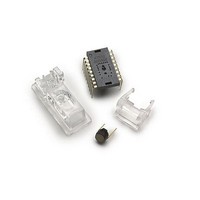ADNB-7051-EV Avago Technologies US Inc., ADNB-7051-EV Datasheet - Page 7

ADNB-7051-EV
Manufacturer Part Number
ADNB-7051-EV
Description
OPT SENSOR BUNDLE SET FOR A7050
Manufacturer
Avago Technologies US Inc.
Specifications of ADNB-7051-EV
Description/function
Laser Mouse Bundle
Interface Type
SPI
Product
Display Modules
Touch Panel
No Touch Panel
For Use With/related Products
ADNS-7050
Lead Free Status / RoHS Status
Lead free / RoHS Compliant
Lead Free Status / RoHS Status
Lead free / RoHS Compliant, Lead free / RoHS Compliant
7
LASER Drive Mode
The laser is driven in pulsed mode during normal opera-
tion. A calibration mode is provided which drives the la-
ser in continuous (CW) operation.
Eye Safety
The ADNS-7050 and the associated components in the
schematic of Figure 5 are intended to comply with Class
1 Eye Safety Requirements of IEC 60825-1. Avago Tech-
nologies suggests that manufacturers perform testing to
verify eye safety on each mouse. It is also recommended
to review possible single fault mechanisms beyond those
described below in the section “Single Fault Detection”.
Under normal conditions, the ADNS-7050 generates the
drive current for the laser diode (ADNV-6340).
In order to stay below the Class 1 power requirements,
LASER_CTRL0 (register 0x1a), LASER_CTRL1 (register
0x1f ), LSRPWR_CFG0 (register 0x1c) and LSRPWR_CFG1
(register 0x1d) must be programmed to appropriate val-
ues. The system comprised of the ADNS-7050 and ADNV-
6340, is designed to maintain the output beam power
within Class 1 requirements over components manu-
facturing tolerances and the recommended tempera-
ture range when adjusted per the procedure below and
implemented as shown in the recommended application
circuit of Figure 5. For more information, please refer to
Eye Safety Application Note AN 5230.
LASER Power Adjustment Procedure
•
•
•
•
•
•
•
•
•
The ambient temperature should be 25°C ±5°C.
Set VDD to its permanent value.
Set the Range bit (bit 7 of register 0x1a) to 0.
Set the Range_C complement bit (bit 7 of register
0x1f ) to 1.
Set the Match_bit (bit 5 of register 0x1a) to the correct
value for the bin designation of the laser being used.
Set the Match_C_bit (bit 5 of register 0x1f ) to the
complement of the Match_bit.
Enable the Calibration mode by writing to bits [3,2,1]
of register 0x1A so the laser will be driven with 100%
duty cycle.
Write the Calibration mode complement bits to
register 0x1f.
Set the laser current to the minimum value by writing
0x00 to register 0x1c, and the complementary value
0xFF to register 0x1d.
•
•
•
•
•
•
Good engineering practices such as regular power meter
calibration, random quality assurance retest of calibrated
mice, etc. should be used to guarantee performance, reli-
ability and safety for the product design.
LASER Output Power
The laser beam output power as measured at the naviga-
tion surface plane is specified below. The following con-
ditions apply:
1. The system is adjusted according to the above
2. The system is operated within the recommended
3. The VDD value is no greater than 300mV above its
4. No allowance for optical power meter accuracy is
Parameter Symbol Minimum Maximum Units Notes
Laser out- LOP
put power
Program registers 0x1c and 0x1d with increasing
values to achieve an output power as close to 506uW
as possible without exceeding it. If this power is
obtained, the calibration is complete, skip to step 14.
If it was not possible to achieve the power target, set
the laser current to the minimum value by writing
0x00 to register 0x1c, and the complementary value
0xff to register 0x1d.
Set the Range and Range_C bits in registers 0x1a and
0x1f, respectively, to choose to the higher laser current
range.
Program registers 0x1c and 0x1d with increasing
values to achieve an output power as close to 506uW
as possible without exceeding it.
Save the value of registers 0x1a, 0x1c, 0x1d, and 0x1f
in non-volatile memory in the mouse. These registers
must be restored to these values every time the ADNS-
7050 is reset.
Reset the mouse, reload the register values from
non-volatile memory, enable Calibration mode, and
measure the laser power to verify that the calibration
is correct.
procedure.
operating temperature
value at the time of
assumed.
adjustment.
716
range.
µW
Class 1 limit with
recommended
VCSEL and lens.






















